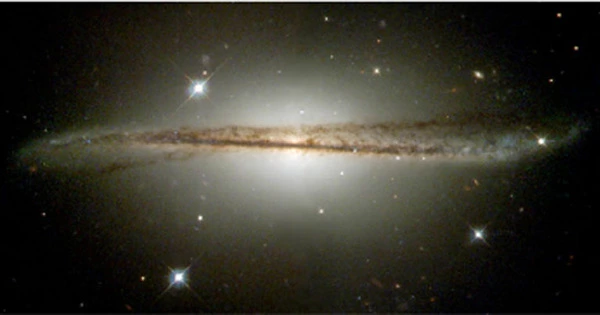Quasars (or QSOs) are the brightest objects in the Universe, with the exception of the short-lived, powerful explosions responsible for supernovae and gamma-ray bursts. They are believed to be powered by supermassive black holes (black holes with masses greater than one billion solar masses) found at the centers of massive galaxies. However, black holes do not emit visible or radio light; the light we see from quasars comes from an accretion disk, which is a disk of gas and stars that surrounds the black hole.
Using a global network of radio telescopes, scientists have observed the narrowing of a quasar jet for the first time. The results suggest that the narrowing of the jet is independent of the activity level of the galaxy which launched it.
For the first time, an international team of scientists used a global network of radio telescopes to observe the narrowing of a quasar jet. According to the findings, the narrowing of the jet is independent of the activity level of the galaxy that launched it.
In the center of nearly every galaxy is a supermassive black hole. In some cases, gas falling toward a black hole releases enormous amounts of energy, resulting in a phenomenon known as a quasar. Quasars produce narrow, collimated jets of material that travel at nearly the speed of light. However, how and where quasar jets collimate has long been a mystery.
The team discovered that the jet emitted by the quasar narrows over a very long distance. This narrowing section of the jet extends far beyond the area where the black hole’s gravity dominates.
An international team led by Hiroki Okino, a graduate student at the University of Tokyo, and including members from the National Astronomical Observatory of Japan (NAOJ), the Massachusetts Institute of Technology, Kogakuin University, Hachinohe National College of Technology, and Niigata University, captured an image with the highest angular resolution to date that shows the deepest part of the jet in a bright quasar known as 3C 273.
The team discovered that the jet emitted by the quasar narrows over a very long distance. This narrowing section of the jet extends far beyond the area where the black hole’s gravity dominates. The findings show that the jet’s structure is similar to that of jets launched from nearby galaxies with a low luminosity active nucleus. This would imply that the jet’s collimation is independent of the level of activity in the host galaxy, providing an important clue to understanding the inner workings of jets.

Research for GB1428 began when Cheung, then at Stanford, compiled a list of the most distant quasars in a large region of sky. The team set about systematically making radio images of them using the Very Large Array of 27 radio telescopes in New Mexico. Radio imaging was his Ph.D. project of Gobeille.
Cheung, who is now at the Naval Research Laboratory in Washington, D.C., said his team is excited about this result not only because it is a world record, but also because there are very few X-ray jets known in the early universe.
Because the brightness of the jet in X-rays depends, among other things, on how fast the jet plasma is moving away from the black hole, discoveries like the jet in GB 1428 tell us something about the environment around supermassive black holes and their host galaxies not long after the Big Bang, according to co-author Lukasz Stawarz of the Japan Aerospace Exploration Agency in Kanagawa, Japan.
X-rays are thought to be produced when fast electrons in the jet collide with photons (light particles) from the cosmic background radiation, which is the glow from the Big Bang. Electrons lose energy, while photons are accelerated to X-ray energies. Because the quasar was discovered when the universe was 1.3 billion years old, cosmic background radiation was a thousand times stronger than it is now. This significantly increases the brightness of the jet, partially compensating for the dimming
















